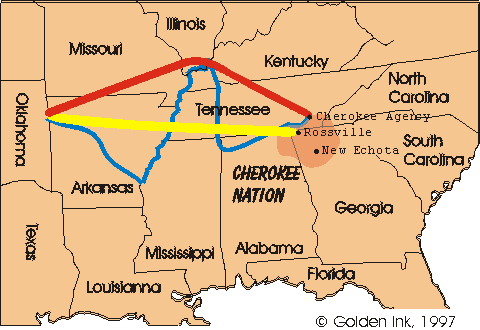 Trail of Tears
Trail of Tears
The Trail of Tears and the Middle Passage are journeys to the first of the concentration camps—Indian reservations and plantations—and the beginnings of the U.S. strategy to work the captured and colonized to death.
I went through the Trail of Tears exhibit at the Cherokee National Museum about two and a half years ago; I went though it again with my father the next year. I had just read Wilma Mankiller’s book “A Chief And Her People” before I went the first time, and I got to hear the Principle Chief of the Cherokee Nation (1985-1995) speak about atrocities that happened in 1838 on the Cherokee Trail Of Tears, though that wasn’t her primary topic that night. Walking through the Trail Of Tears exhibit was a powerful experience, and has ended with tears of my own…
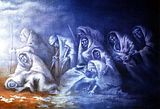 http://photobucket.com/images/search/cherokee%20trail%20of%20tears/
http://photobucket.com/images/search/cherokee%20trail%20of%20tears/
The exhibit begins in a reconstructed room appropriate to a cabin in 1839. Antique furniture and oil lamps grab the attention until an automated voice says (I’m going on pure memory), “Hurry up, get your things. Let’s go. Move!” It gives the feeling of surprise while the sounds of soldier’s footsteps are heard. I want to stop here and fill in what I think many people miss. To illustrate, I quote my college history professor who said, “Once you get into prison camps, it’s a whole different ball game (once again, pure memory).” Those prison camps were also called Cherokee Removal Forts.
Dr. Sarah Hill conducted an extensive research project for the National Park Service and the Georgia Department of Natural Resources/Historic Division in 2005. Her project, Cherokee Removal: Forts Along the Georgia Trail of Tears, is available Online in PDF format via the National Park Service at their Web site
The reader needs to understand that the Cherokee are a matriarchal society. Plainly put: the clan mother can trump the chief, women choose HER mate based on HIS cooking skills, and a man knew he was divorced if all his things were outside when he got home. So when the soldiers raped the women in the prison camps and on the Trail of Tears, they raped the tribe’s leaders as well. It was about taking away power. When the soldiers passed the women around like whiskey bottles raping them, it was about taking away power. When the soldiers scalped the women’s genitalia and wore their vaginas on their hats, it was about raping power to the most excruciating degree imaginable. I think it’s common knowledge how soldiers identified “leaders” in concentration camps and killed them, in order to keep the hostages under control. I can’t help but remember the old adage:
”Those who do not know their history are condemned to repeat it.” — Georges Santayana. …
History is repeating, and only a fictional movie can begin to explain it to me.
Scene from “Exorcist III”:
EXORCIST III The Gemini Killer: I kill at random… no motive… that’s the fun. __________________Dt. Kinderman: This I believe in… I believe in death. I believe in disease. I believe in injustice and inhumanity, torture and anger and hate… I believe in murder. I believe in pain. I believe in cruelty and infidelity. I believe in slime and stink and every crawling, putrid thing… every possible ugliness and corruption, you son of a bitch. I believe… in you.
Although in the end, reality is more terrifying than fiction, since heroes are easily made with imagination who can save the helpless. Finding a congress willing to impeach is much more difficult than finding a priest willing to perform an exorcism;
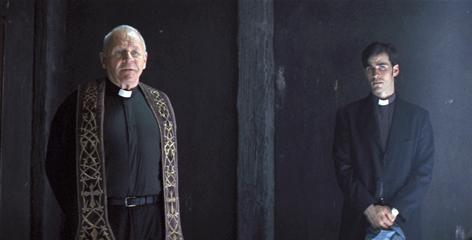 The Rite www.google.com/…:
The Rite www.google.com/…:
subsequently, I bet I could find a priest if I really needed one.
Trump hangs portrait of Andrew Jackson in Oval Office
President Trump hung a portrait of Andrew Jackson in the Oval Office on Tuesday,
The New York Times reports, an apparent nod to the populist sentiments of the new administration.
– snip –
Trump has also expressed admiration for the seventh president, as well, calling Jackson “an amazing figure in American history — very unique so many ways,” through a spokesperson last week.
Immigrants in detention include undocumented and documented immigrants, many who have been in the U.S. for years and are now facing exile, as well as survivors of torture, asylum seekers and other vulnerable groups including children, pregnant women, and individuals who are seriously ill.
In detention, immigrants are often subjected to harsh conditions of confinement and denied access to adequate medical care, legal counsel and family contact. Since 2003, a reported 155 people have died in immigration custody.
“The most effective way to destroy people is to deny and obliterate their own understanding of their history.”
― George Orwell

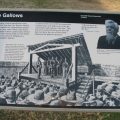


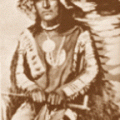
Leave a Reply